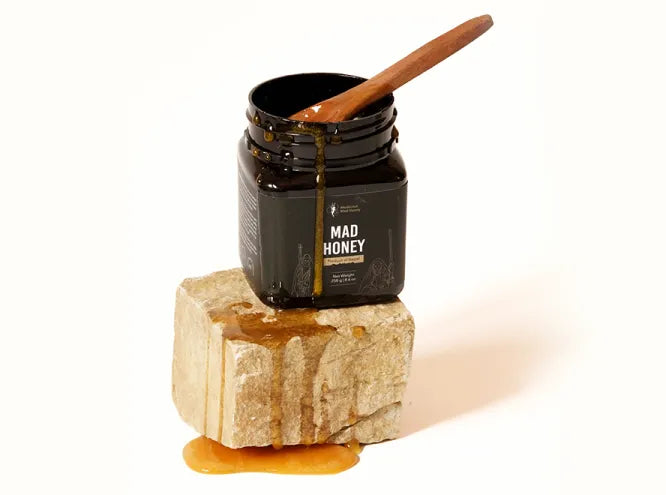There are more than 300 kinds of honey available in the world! The general idea when one hears about honey is that it’s sweet and healthy. But how many of you know there are honey of variety types and the differences they hold? One certain instance you have heard about is of Raw Honey.
What is Raw Honey?
Raw honey is a type of honey in raw form where harvesters simply strain their honey lightly to discard beeswax together with dead bees after extraction from the beehive. Raw honey is different from regular honey since its preparation avoids pasteurization and heavy filtration process. These, steps help further with the conservation of nutritious elements like pollen and propolis. High pasteurization temperatures used in regular honey production destroy beneficial enzymes at the same time that they smooth out and extend the shelf life of the product. Scientists have not fully analyzed how less processing in raw honey affects health benefits but natural preservation benefits exist. Individuals choose raw honey because they want to benefit from its natural nutritional content as well as its untouched state.
Health Benefits of Raw Honey
-
Rich in Antioxidants: Raw honey possesses plant compounds called polyphenols that function as strong antioxidants in the human body. These antioxidant compounds assists in fighting free radicals and reducing body stress from oxidation. The consumption of raw honey helps decrease the chance of developing chronic diseases that affect the heart as well as certain types of cancer.
-
Antibacterial and Antifungal: The antibacterial along with antifungal effects of raw honey stem from its components hydrogen peroxide and bee propolis. As a result of antibacterial and antifungal qualities in raw honey bacteria-causing infections become less likely. Manuka honey stands apart from other raw honey varieties because it shows exceptional antibacterial strength.
- Supports Wound Healing: Within hospitals medical-grade honey serves as treatment for skin burns along with treating wound injuries. Medical-grade honey provides dual functions which maintain wound moisture and support tissue regrowth and inhibit infections. The antimicrobial properties together with protective capabilities create these effects in medical-grade honey.
- Boosts Immunity: Raw honey contains phytonutrients that have immune-boosting benefits. These natural compounds help the body respond to harmful bacteria and inflammation. Regular consumption in moderation may strengthen the body’s natural defenses.
- Soothes Sore Throat and Cough: The common household ingredient honey acts as a well-known natural remedy to treat sore throats while easing cough symptoms. The adhesive nature of honey covers throat tissues to provide relief from irritation thus improving relaxation. Scientific research indicates that honey shows similar effectiveness to some OTC cough meds for helping people sleep at night.
- Aids Digestion: Raw honey includes prebiotic substances that support beneficial gut bacteria growth. Human health relies on the beneficial function of digestion and total wellness maintained by a healthy gut microbiome. Raw honey can help alleviate the symptoms of minor digestive conditions such as diarrhea and ulcers.
- Provides Nutrients: Raw honey offers small amounts of essential nutrients such as calcium, magnesium, and zinc. It also contains amino acids and enzymes that can support overall health. Though not a major source, these nutrients add value compared to processed sugars.
- May Support Brain Health: The antioxidants in raw honey may protect brain cells from damage and reduce inflammation. Some research suggests it could help improve memory and mood. It may also help reduce the risk of neurodegenerative diseases like Alzheimer’s.
Similarly, there is a rare kind of bee nectar found in Nepal that has certain unique factors. These factors make mad honey stand out among all other kinds. The Mad Honey is sold in raw unprocessed form, but that doesn't mean they are same and can be used interchangeably. So, are raw honey and Mad Honey same? No, raw honey can't be Mad Honey but Mad Honey can be in raw form. Hence both of these are not same.
Also, we have covered basic difference between these two.
Raw Honey vs Mad Honey
Both raw honey and mad honey have potential health benefits. It would be unfair to say that the usual bee nectar does not serve us anything. Raw honey is packed with various nutrients. However, mad honey amplifies the benefits.
Here are a few differences between raw and mad honey based on their properties.
Source
Honeybees (Apis mellifera) create regular honey by gathering nectar from a diverse range of flowers and plants. They travel from one flower to another gathering the sugary nectar which is later transported back to their hives. The honey harvested and sold without further processing makes it raw honey.
Within the hive, the bees undergo a process of regurgitation and evaporation to transform the nectar. Enzymes from the bees salivary glands aid in breaking down the intricate sugars in the nectar into more basic sugars, while water is evaporated, yielding the familiar dense and sweet liquid known as honey. The honey making process is same for all types of bees except the floral source. Raw Honey is made from any floral source available but Mad Honey is primarily made by the Himalayan Giant Honey Bees known as Apis Dorsata and they primarily feed on the nectar of Rhododendron Plants.
Also Read: Manuka Honey vs Raw Honey
Nutritional Profile
Raw Honey has similar nutritional profile of Mad except Mad Honey has Grayanotoxin in them. The natural neurotoxin is collected during the foraging and nectar collection by the Wild Bees from flowers of Rhododendron plants. Natural sugars like fructose, glucose, enzymes, pollen are found in almost same quantities in both these types of honey.
Color & Texture
The color of Raw Honey is golden to amber and thicker in terms of viscosity but Mad Honey is reddish or darker red brown in appearance, more watery and less viscous. The color of both these honey is directly influenced by the floral source which can vary in raw honey but always same in the Mad Honey as the primary floral source is Rhododendrons.
Taste and Aroma
The taste of Raw Honey primarily depends on the floral source and usually sweet but the taste of Mad Honey is primarily bitter and sharp. While the smell of Raw Honey is floral the smell of Mad Honey is bit earthy.
Geographic Origin
Raw Honey is found worldwide but primarily the traces of Mad Honey origin is from Turkey and Nepal.
Pricing
As we all know a unique and advantageous product always comes at top. This is one along with other several reasons why mad honey is expensive in comparison with the raw honey.
Sugar Content
Raw Honey has slightly more sugar content in terms of Glycemic Index as compared with Mad Honey, although they nearly have same levels of Glycemic index. So, the question, Is Mad Honey good for diabetes? is answered in moderate level.
On the other hand, Raw Honey lacks the mind-relaxing compound found in Mad Honey. While Raw Honey does offer antioxidants, minerals and vitamins, its effects are less euphoric compared to hallucinogenic honey containing Grayanotoxin.
Conclusion
Both these honey are unique in their own types with different applications but remember choosing best one depends on the utility. Where and how often are you using directly influences the product. You can use Raw Honey on daily basis but using Mad Honey on daily basis can be costly. Also, if you are outside of US it is important to understand legality of mad honey as it is banned on some countries.
FAQs
Does Raw Honey make you high?
No, Raw Honey doesn't make you high unless it contains Grayanotoxins or Mad Honey in the raw form. Always check labels before purchasing.
Does Raw Honey have side effects like Mad Honey when overdosed?
No, the hallucinogenic side effects of Mad Honey is because of the Grayanotoxins which is not present in the raw honey. But still we suggest you to stay within the dosage guidelines of Honey.
Is raw honey recommended for kids and pets?
No, raw honey is not recommended for kids below 4 years of age due to risk of infant botulism and for pets like dogs and cats, it is not recommended because of high sugar content.






